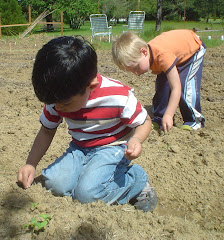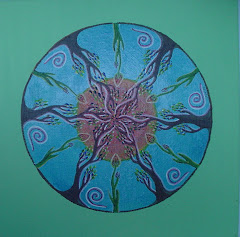
Alpine Community Garden - May 2009
The Alpine Community Garden is off to a great start! We've got all but about five rows of the 80'x 100' plot planted, and the fence (mostly) in place. If you live nearby, c'mon down to see the progress we've made in the last month. Remember, the Alpine Community Garden is growing food for the Monroe Food Bank, the Senior Lunch Program in Monroe and others in need in our community. "Give what you have, receive what you need." Contact us by email at AlpineCoGarden@gmail.com if you have donations, comments, would like to volunteer or would like to be added or removed from this regular blog-update. Also, if you are local and know of anyone with mulch materials who may not get this blog, please forward it, or give them our number. Thanks. Chris and Llyn 541-847-8797
Today's blog is about the benefits of mulching your garden. We are in need of significant quantities of mulch. Ideally we prefer bedding straw (either baled or raked out of animal stalls), spoiled hay (maybe you have some bails that are moldy or otherwise unsuitable for feeding to livestock that we could use in the garden), leaves from last fall (it's probably too late to rake them from under trees but if you've got a big pile we could collect, we'd be interested.) or grass clippings (either in a pile, or drying on your lawn, so we can rake them up) . Ideally, we'd love to have mulch-materials delivered to the garden but let us know what you've got and maybe we can come collect them from your home or farm.

Autumn Leaves Mulching the Broccoli and Peas from a Previous garden
The next big step for the garden's health involves a heavy mulching on the pathways between the rows. The method of organic gardening that we're doing focuses on feeding the soil and nourishing a healthy environment for worms, beneficial insects and micro-organisms. Soil is composed of sand, clay and decomposing plant/organic material (bio-mass). If these components are out of balance, crops will suffer. Mulching adds bio-mass to the soil, helps retain moisture (so you don't have to water as much) and, along with worm castings, compost and the small amount of organic fertilizer were adding, literally feeds your mini-livestock (worms, bugs and micro-organisms). They in turn correct the acid/alkaline balance in the soil, dig little tunnels that provide easy pathways for the plant's rootlets to grow into and digest the mulch thereby making all the nutrients locked into the bio-mass available to your garden, (worm poop (or castings) is like vitamins for your soil!) . Mulching also blocks weeds from getting sunlight so they can't grow, which cuts down on the need for weeding.
As we have prepared the garden this first year in Alpine, we dug soil out of the paths and heaped it in mounded rows. This makes the soil deeper and looser in the rows, making it easier for plants to grow. We will mulch heavily, primarily in the paths where we walk. Though we've got exceptionally good soil for a first-year garden, it seems that it has more clay than is ideal. The mulch we add in the paths between rows will decompose from sun and rain and worms and micro-organisms and make next-year's garden even better because of this added plant matter.
Many people don't realize that a plant's root system may reach out well into the pathways. Another advantage of mulching is that you make the soil less likely to become compacted in the pathways, and it's also more pleasant to be on your knees when weeding, or harvesting plants.
Here are the kinds of mulch we prefer, and why:

Bedding straw: Straw is from the stalks left standing after grains are harvested (wheat, barley, rye). It consists just of the lower stems of the plant. We prefer the straw because it doesn't have as many seed-heads (which means less weeding for us). We can use straw straight out of the bale, or raked out of animal stalls. The benefit of used straw is that it contains urine and manure from the livestock which functions as fertilizer for the garden. We can also use spoiled hay. (Pictured at left) (If you are using straw or hay to build your compost piles, or deeply mulch your garden, please read our post about Herbicide Contamination of Compost, Manure and Mulch)
Autumn Leaves: Leaves from maples and fruit-trees are some of our favorites. In the fall we either put them directly in the garden rows so they will decompose over the winter or rake them into big piles and cover them in plastic for use in the spring. Not all leaves are beneficial. Walnut leaves (for example) are toxic to many plants and will retard their growth or actually kill them. (Below: A big load of autumn leaves diverted from the landfill/burn-pile)

Grass Clippings: Some people like to leave grass clippings on their lawns/fields because they act as a mulch and fertilizer for the growing grass. Other people have collection-bags on their mowers and pile their grass clippings in one place. Grass clippings make an excellent garden mulch and fertilizer as they are easy to spread and compost readily making the nutrients easily available to your plants. We don't recommend bagging up your lawn clippings because they will become a stinky, gooey mess if they decompose in an airtight container or bag. If you wish to save grass clippings for later use, either leave them in the lawn/field for a few days in the sun and rake them after they've dried or use your bagger-mower to collect and then spread them just a few inches thick on a large sheet of plastic, in the sun, and they will dry quickly. Then you can store them in bags for use at a later time. (Below: Spoiled hay mulching on a lawns-to-gardens project. Cox Lane Garden)

In this 'full-circle' style of gardening, we are always looking for ways to pull materials out of the waste stream (taking up room at the land-fill, or being burned in burn-piles) and save money by re-using and recycling. In the garden, "one man's trash" can truly be "another man's treasure". Let us know if you have any of these mulching materials available, so we can take them off your hands and turn them into 'garden treasure'. Chris and Llyn: 847-8797 AlpineCoGarden@gmail.com
Thank you to Gary Weems for donating time and materials to get the toilet working again at the Alpine Park. Thanks to Steve and Beatrice Rose for housing our tomato-starts in their greenhouse this spring. Thanks to Patty Parsons for writing the grant and to the South Benton Foundation for awarding our project $350 (this means that cash donations have now surpassed $1000.) Thank you to Dorothy Brinckerhoff for being our treasurer (and all-around go-to gal!). We also appreciate Phil Hawkins and Emily Smith for the picture spread and article that featured our Alpine Park clean-up day in the Tri-County news.

Fun in the leaf pile!















































